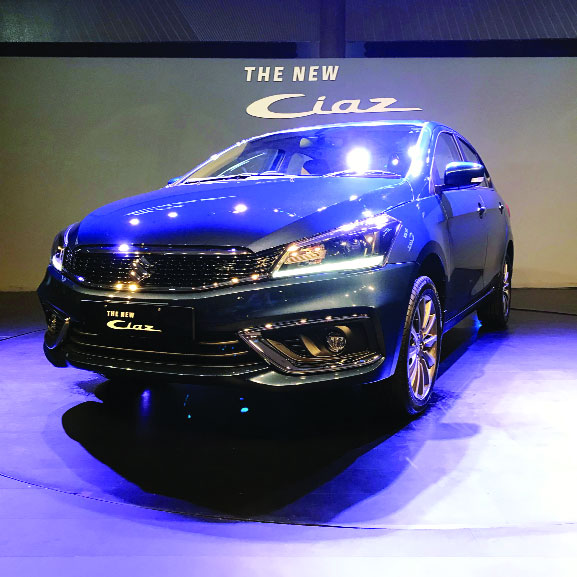Maruti has given the car a new engine, a new front fascia and a lithium-Ion battery pack across the board.
Maruti-Suzuki’s Ciaz was never considered the sales star in its segment, competing as it did against the Honda City and Hyundai Verna. Yet, by managing to deliver a proposition that was reliable, spacious and economical, the Ciaz held an impressive one-third share in the so-called ‘A3’ segment. However, the Ciaz had been showing signs of what one would describe as tiredness, particularly on the looks and power front. The petrol K14 engine didn’t deliver as much power as its rivals, and faced with smart-looking rivals the Ciaz was increasingly becoming a Indian babudoms car of choice, and while institutional sales do matter, the Ciaz needed to appeal to private buyers once again and its mid-life refresh was expected to do just that.
And Maruti has delivered us an updated car with not just much improved looks, the new front-end of the Ciaz with its redesigned fascia and new smart signature lED lights is a smart looking car indeed, even if changes at the rear have been a bit more limited. The interiors too have become brighter and the top-end model gets a faux-birchwood trim finish, I am personally not a huge fan of such trims, but it does not look or feel out of place in the Ciaz.
But the big change with the new Ciaz, rather the refreshed Ciaz, is with the petrol engine. The new engine is slightly larger, displacing 1468cc and has a new name, the K15B, a continuation of Maruti’s successful K-series of petrol engines. The new powerplant delivers an impressive, but pretty much bog-standard for the segment, 103 horsepower. But where Maruti have been innovative here is that they have added a lithium-Ion battery pack to the underbody of the car, as standard fitment. Combined with the Integrated Generator Starter (IGS) and a larger regular lead-acid battery in the engine bay, they have made the Ciaz into what Maruti describes as an ‘Advanced Smart Hybrid’ and what we would call a ‘mild’ hybrid.
Now, we do not want to get into the wordplay around this, but this is not a hybrid in the conventional sense. A proper conventional hybrid can technically run the car on either energy source, that is the internal combustion engine or the the battery pack. Despite the new lithium-Ion battery pack, the Ciaz cannot run on battery power alone, unlike say the Honda Accord or Toyota Camry available in India. So in that sense, it is not a hybrid in the conventional sense of the word. But that battery pack is not adding deadweight to the car. While it provides no additional power, it does a couple of things, it provides a boost of power when you are accelerating and powers the car when the start-stop system is engaged at traffic lights for example. So, this means that the Ciaz petrol is by far the most economical car in its segment with an ARAI-certified fuel-economy of over 21 kilometers per litre.
Driving the Ciaz, I tried the manual-gearbox variant of the car, you see quite quickly that it is not the thirstiest car on the road. In the city it can easily deliver a fuel economy exceeding 14kmpl, very impressive for a car of its size. As for the power delivery, it definitely does palpably seem better, especially as you accelerate away from traffic, with the battery kicking in. So, it appears the Ciaz does gain a upper hand on some of the competition, however truth be told it has some weaknesses. Maruti’s tried and tested 1.3 litre diesel engine is getting very long in the tooth now and even if the diesel Ciaz will have incredible economy, it is underpowered compared to the competition.
Despite the new engine and being a reliable mile-muncher on the highway, it is not the most exciting car to drive in its class, and the four-speed automatic I drove for a short while is the weakest clutch-less option in its class.
However, the Ciaz has one major advantage over its rivals. It remains the most spacious car in its class, both in terms of rear-legroom and boot space. And that makes it an attractive proposition for those who buy a car in this segment to be driven around in, and even if the front-end looks smarter, it doesn’t feel flash in any way. So, there you have it, a better-looking Ciaz and now one with added economy.
PS: There is something else I discovered on this drive with the Ciaz. As part of the new safety regulations that insist on ABS and airbags on all cars come April 1, 2019, there are also speed-warning buzzers. You get a single beep when you cross 80kmph, and that is fine since the speed limit on most highways is 90kmph, but cross 120kmph as one of my colleagues did, and the beeping is constant. Given that some new expressways are being built around a speed limit of 120kmph, this seems like unnecessary nannying to me.


























